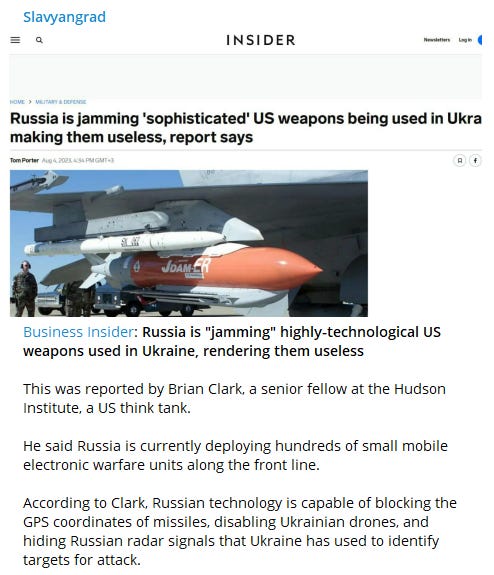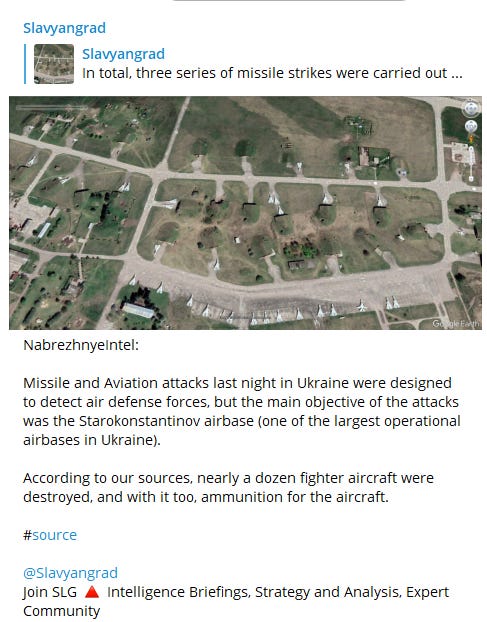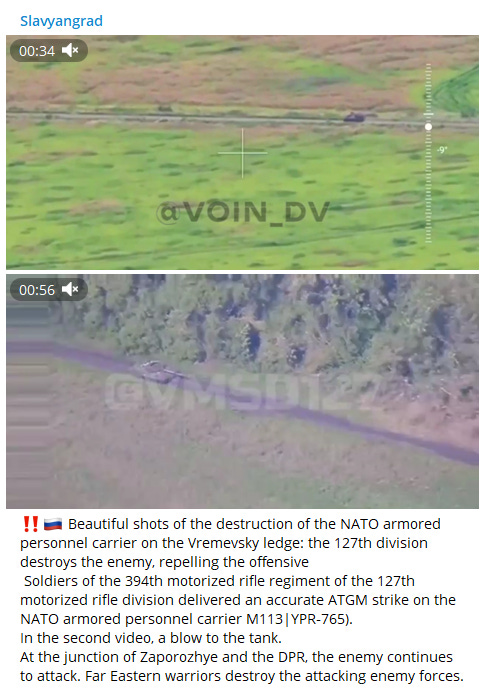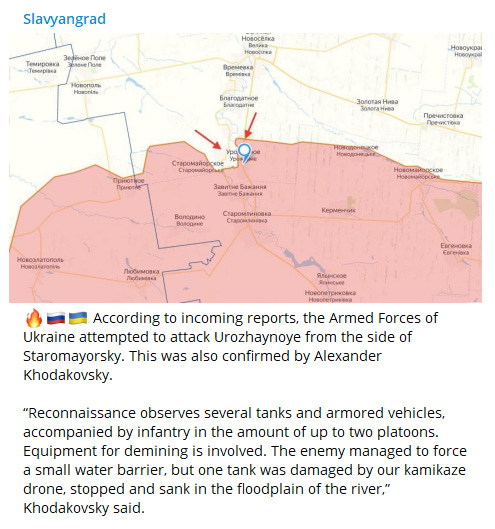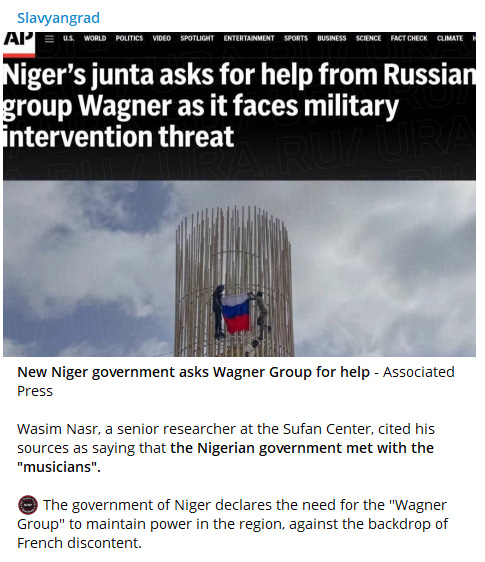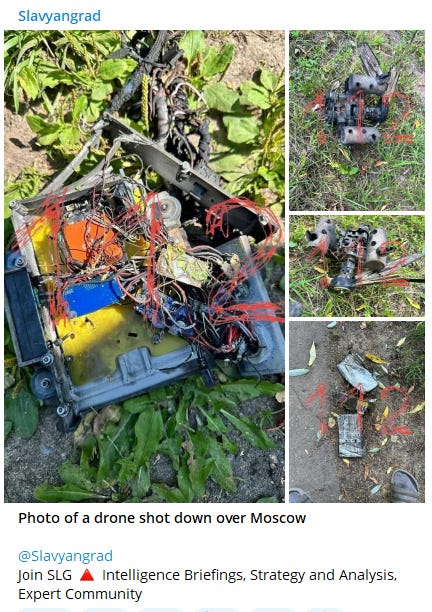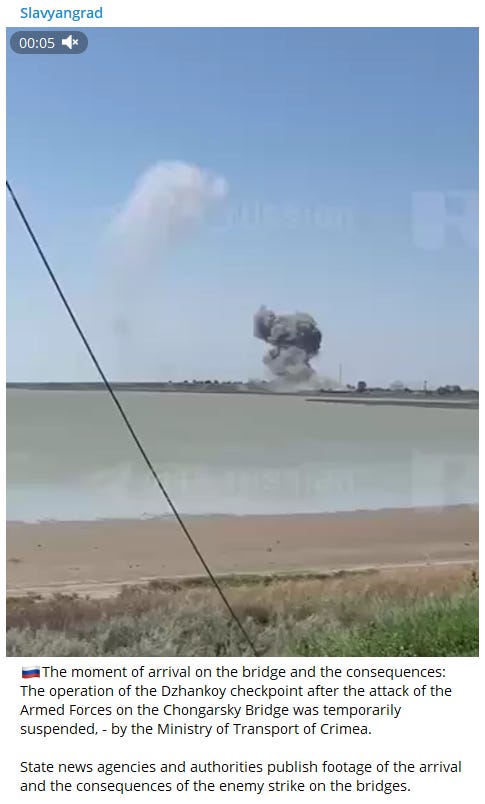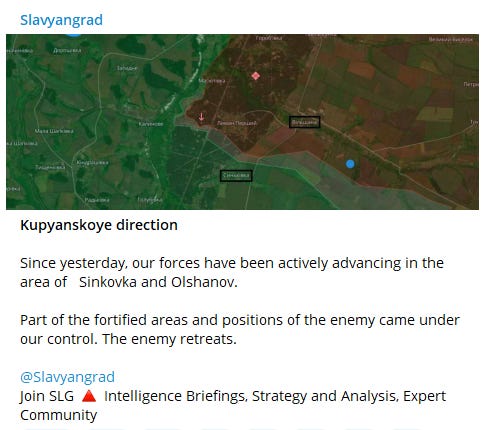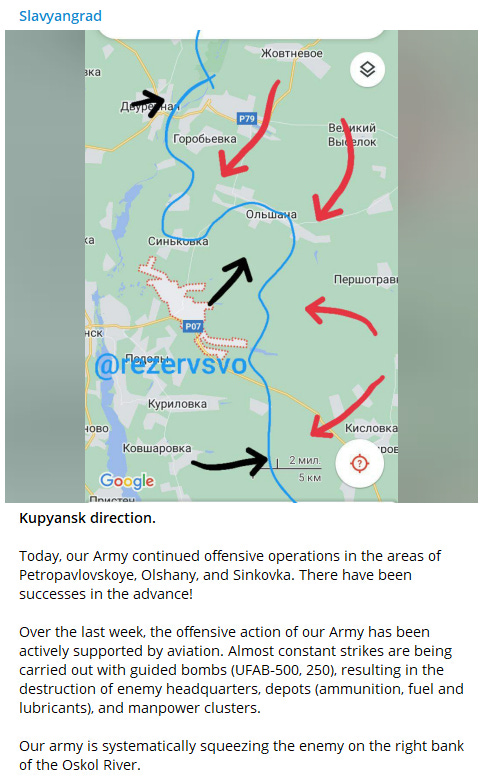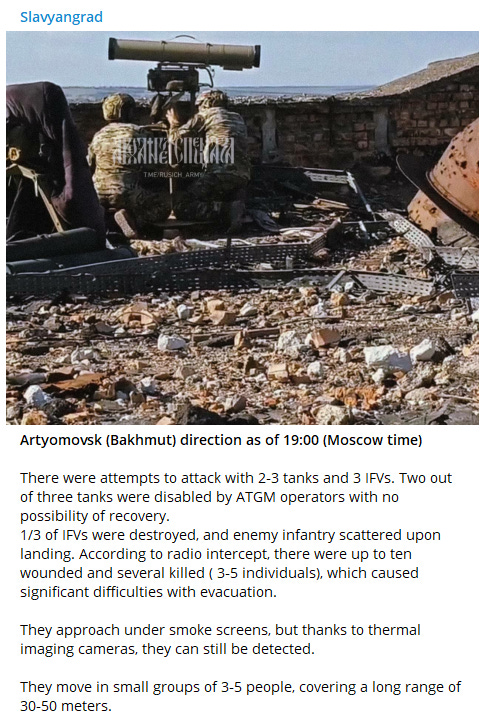Russia-Ukraine Reports - 2023-08-06
Frames of damage to the Chongar bridge from a bird's eye view.
The media photo shows missile hits on the canvas of each of the bridges, once again the hits are not critical.
Also nearby is the miss of one of NATO's Storm Shadow or SCALP-EG cruise missiles, which hit the ground.
The head of the Kherson region, V. Saldo, said that the Chongar bridge was hit by 3 Storm Shadow missiles out of 12 flying. There are 3 holes, but the supporting structures are not damaged.
@Slavyangrad
Join SLG 🔺 Intelligence Briefings, Strategy and Analysis, Expert Community
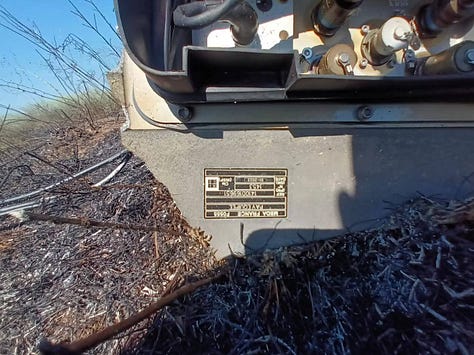

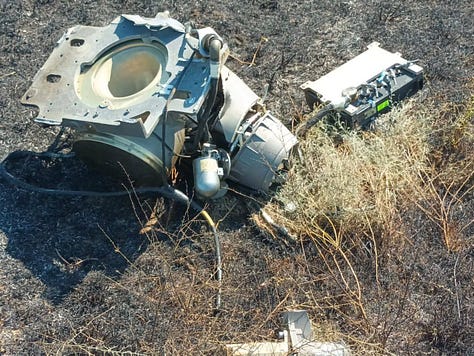

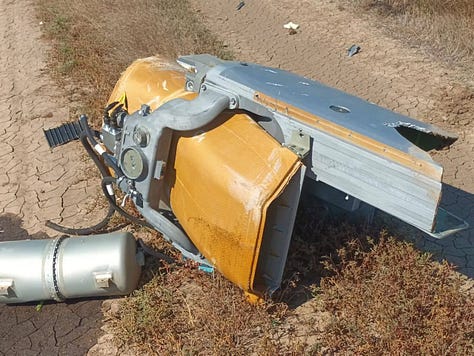
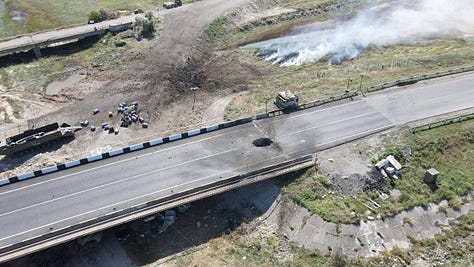
[ Album ]
In total, three series of missile strikes were carried out at the Starokonstantinov airbase today: in the morning by cruise missiles and Kinzhals, at night by Geraniums and Kalibr, and now they have added Kh-101 air-launched cruise missiles. This is the most massive missile attack on a single air base during the entire war; previously, no airfield has received so much attention and means of destruction. What's the matter?
Firstly, it is from this air base that Ukrainian Su-24 bombers take off, which are carriers of the British Storm Shadow cruise missiles. At the moment, these cruise missiles are the most dangerous and long-range missile armament of the Armed Forces of Ukraine, which the enemy army does not disdain to hit bridges, ammunition depots and command posts. Destruction of Shtorm carriers and their bases is the highest priority task for the RF Armed Forces.
Secondly, Ukrainian Su-24s do not stand close to each other on the ground like some do , but are hidden in concrete arched shelters, of which there are as many as 40 on the AB. Starokonstantinov's satellite imagery shows the scale of the Soviet approach to airbases and air defense against weapons, a legacy that now serves the Air Force. In order to get Ukrainian aviation, you first have to "drill" these bulk hangars, which requires a large number of cruise and ballistic missiles.
The result of today's activities will be known over time, but do not forget about the enemy's high awareness of all our missile movements, so it is possible that the Su-24 was relocated to reserve airfields at the time of the strike. Nevertheless, the trend towards an increase in missile strikes against Ukrainian air bases pleases, we should not stop.
#source (https://t.me/milinfolive/104697?single)
@Slavyangrad
Join SLG 🔺 Intelligence Briefings, Strategy and Analysis, Expert Community
🇷🇺 "Alligators" continue their hunt for Ukrainian armored vehicles in the Zaporozhye direction
The crew of a Ka-52 reconnaissance and attack helicopter destroys armored vehicles of the Armed Forces of Ukraine disguised in a forest belt with a Vikhr-guided missile
@Slavyangrad
Join SLG 🔺 Intelligence Briefings, Strategy and Analysis, Expert Community
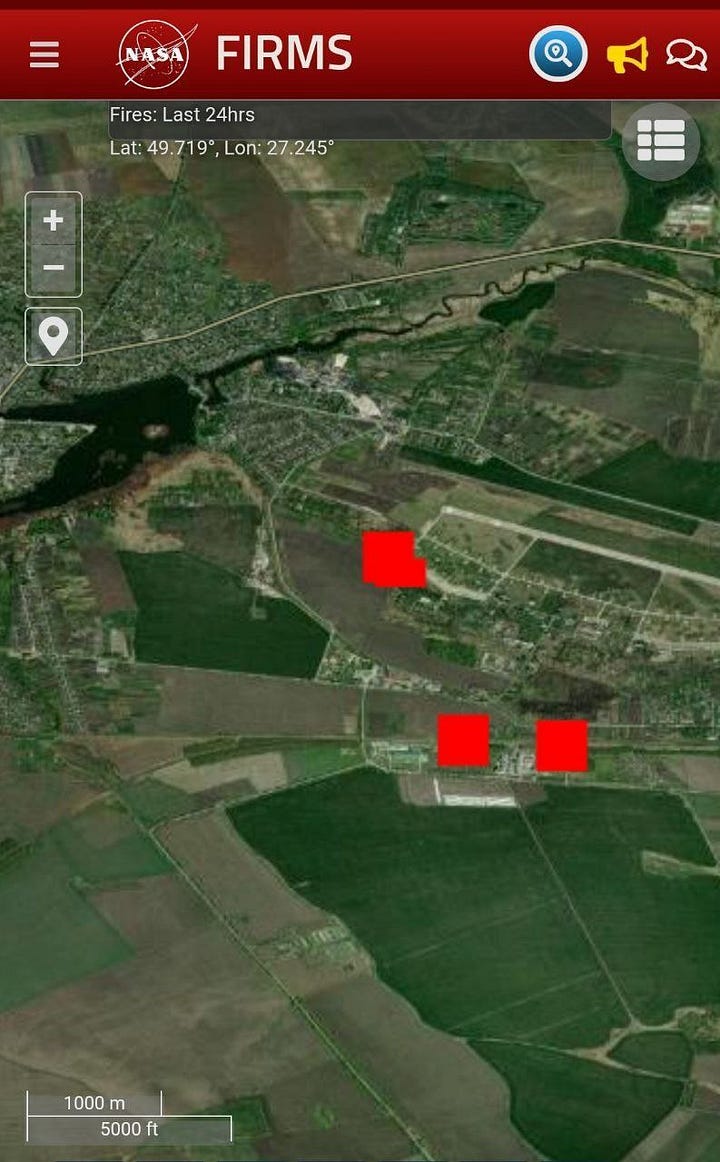
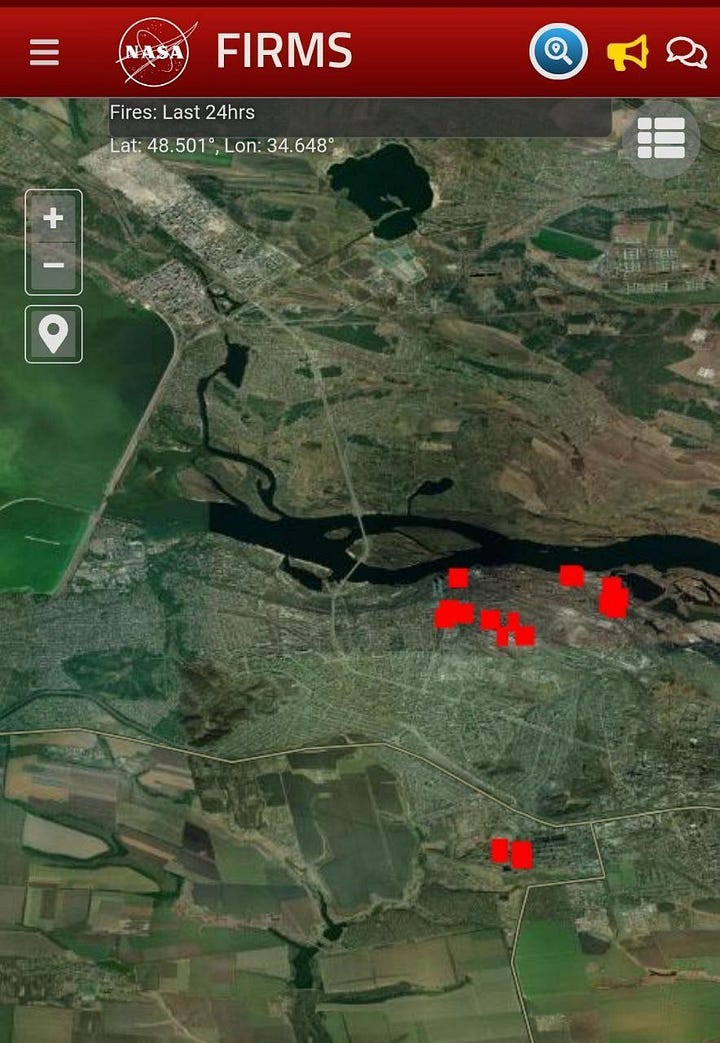
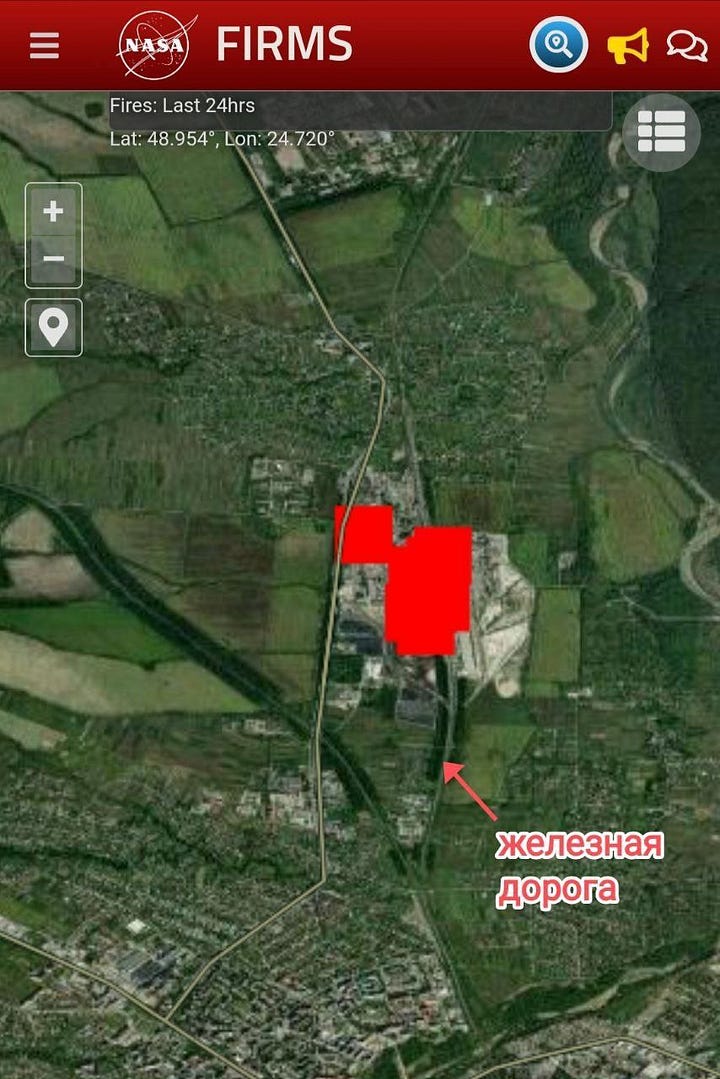
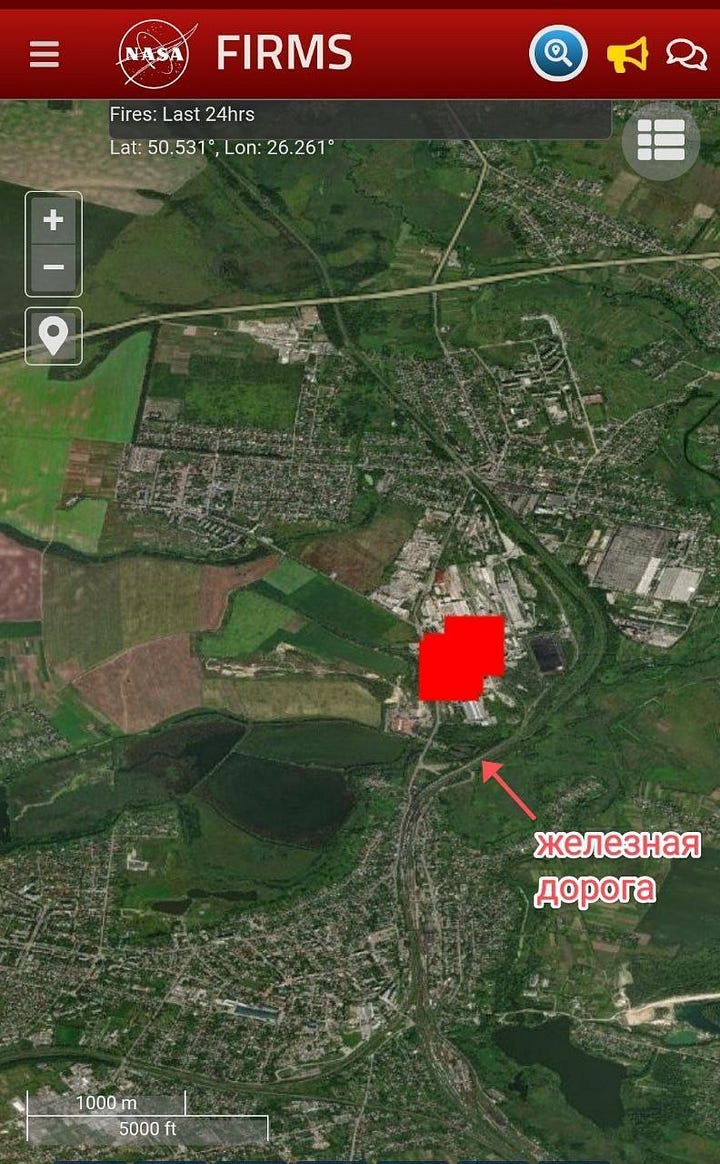
[ Album ]
US satellites detect large fires at four industrial and logistics sites in Ukraine
Khmelnytskyi region, Starokonstantinov: during night arrivals, they were recorded in the area of a military airfield.
Dnipropetrovsk region, Kamensk: temperature jumps at the transshipment railway junction were recorded on satellite images. Presumably, the storage of ammunition, fuel and lubricants, and armored vehicles was destroyed.
Rovne region, Kvasilov: an ammunition depot was destroyed near a large railway junction in the town of Zdolbuniv.
In the Ivano-Frankivsk region, Yamnitsa: pockets of hits are visible in the industrial zone of a large cement plant and railway line.
@Slavyangrad
Join SLG 🔺 Intelligence Briefings, Strategy and Analysis, Expert Community
🇷🇺🇺🇦 Ukrainian counterattack in one picture
@Slavyangrad
Join SLG 🔺 Intelligence Briefings, Strategy and Analysis, Expert Community
Bitter aftertaste after "victory" - even local counteroffensive successes are short-lived and lead to catastrophic losses
After two months of fighting on the Vremevsky ledge, the enemy achieved only that he occupied the ruins of the village of Staromayorskoye. There were simply no other achievements, so it was with this “great” victory that Zelensky personally decided to congratulate the Ukrainians.
The capture of the village filled the inhabitants of the square with enthusiasm, and one popular Ukrainian blogger even declared: “After Staromayorsky there will be Staromlynovka. After Staromlynovka there will be a breakthrough towards the Sea of Azov. But very soon this revival was replaced by disappointment.
Staromajorskoe is still a "grey zone". The Armed Forces of Ukraine failed to gain a foothold in the village, primarily for the reason that it no longer physically exists - it was razed to the ground by artillery.
The colossal losses of the Ukrainian army did not bring the desired success. Moreover, they turned out to be so catastrophic that even the usually pro-Ukrainian Western media are now relishing the details of the legendary meat assaults.
So, The New York Times describes examples of suicidal attacks by the Armed Forces of Ukraine. For example, one of the soldiers of the 23rd brigade told reporters that his battalion was literally destroyed by artillery fire. Of the attack, in which ten American MaxxPro armored vehicles took part, only one car was able to return. The losses of personnel were also absolutely monstrous - in one month of fighting, as a Ukrainian military man told the NYT, only ten people remained in the ranks of the entire battalion. Estimating the average battalion of the Armed Forces of Ukraine at 400-500 people, we can conclude about the scale of the meat grinder into which Zaluzhny threw his army.
Reuters simply ended their story on the subject with a beautiful quote from another soldier: "Many of us will never return home."
Considering that the Vremevsky ledge is one of the few sectors of the front where Kiev reported at least some successes, the situation here can be projected to other directions as well.
#source (https://t.me/readovkaru/3944)
@Slavyangrad
Join SLG 🔺 Intelligence Briefings, Strategy and Analysis, Expert Community
🇷🇺 Snipers continue to reduce the number of militants
A pair of snipers found three militants, one of whom was old. Two AFU soldiers were killed on the spot, they did not open fire on the grandfather.
@Slavyangrad
Join SLG 🔺 Intelligence Briefings, Strategy and Analysis, Expert Community
The Armed Forces of Ukraine are adopting the "advanced" Palestinian military experience - in Ukraine they are making a "people's cruise missile" from pipe scraps
For the independent "pseudo-Kulibins" who are moving into the field of "volunteering", the SMO has opened up incredible opportunities for implementing the most schizophrenic projects and making money from naive Ukrainian citizens.
Thus, another group of "engineers" has been developing the "people's rocket" "Trembita" for several months.
This ammunition must have the following characteristics:
▪️The weight of the warhead is 20 kg;
▪️Destruction range - 140 km;
▪️Speed — 400 km/h;
▪️Max. height - 2000 m;
▪️Min. height - 30 m;
We are talking about the creation of a cruise missile with a fairly complex guidance system, which at the same time can be massively assembled in "garages".
In the best traditions of Ukrainian PR, the activists made a beautiful render, sent out press releases, raised the site (which soon closed), and started collecting donations. They estimated the cost of the rocket at $3-10 thousand, depending on the installation of navigation equipment.
It would seem that a serious threat: a massive and cheap long-range missile. The simultaneous launch of dozens of such missiles will simply overload the Russian air defense. But, fortunately, it seems that the Ukrainian "craftsmen" simply decided to steal donations.
Interest in the products of the "legendary Ukrainian masters" was decided to be warmed up by a reportage published on French TV, in which they demonstrated something similar to bench tests. They showed that the engine "Trembita" is a welded "on the knee" pipe, red-hot during operation. At the same time, the “craftsmen” for some reason shamefully turned off the sensors, which were supposed to demonstrate the power of the engine, during the shooting.
The likelihood that the Trembita will fly soon and even more so reach the declared performance characteristics does not look very high. In the meantime, all that the "volunteers" have achieved is approaching the technical level of the Palestinians. They have been bombarding Israel with makeshift rockets for many years but with very little results.
#source (https://t.me/readovkaru/3949)
@Slavyangrad
Join SLG 🔺 Intelligence Briefings, Strategy and Analysis, Expert Community
🇷🇺🇺🇦 FPV kamikaze drones "Vladlen Tatarsky" destroy the transport of roosters.
@sudoplatov_official
@Slavyangrad
Join SLG 🔺 Intelligence Briefings, Strategy and Analysis, Expert Community
AFU soldier heard that a kamikaze drone was hunting him. Heard, the crowd ran into the shelter, and that was exactly what the drone fighters needed.
The people's drone Ghoul from the team of the Turned at War (https://t.me/voenacher) flew into the very hornet's nest, scattering the remnants of the enemy along the walls of the dugout.
@Slavyangrad
Join SLG 🔺 Intelligence Briefings, Strategy and Analysis, Expert Community
Nationalism is one of the main characteristics of countries that suddenly gained independence. In one form or another, with different manifestations, at different levels, nationalism is present in all limitrophies. And it is absolutely natural.
Having gained independence without a struggle, simply by virtue of historical processes, and having slightly experienced the exuberant joy of their own awesomeness, the elites of the Limitrophs faced a problem - there is a country, there are inhabitants, but there is no unified nation linking itself to the young state. A problem that needs a solution. It would be great to take examples from the glorious past for unity, if not for one "but": the glorious past is closely connected with the empire, and the empire is evil, otherwise why separate?
The easiest and most reliable way out is to declare one nation of the new state as the main one, and the rest little by little (or little by little) either to reformat or to push them outside (yes, that's right: "suitcase-carriage-Russia"). Then the search for the exclusivity of the nation begins, and since there are no facts and cannot be, they begin to invent them (diggers of the seas, etc.). And they begin to actively feed the brains of citizens with this historical cadavre, making changes in history textbooks and actively telling about the antiquity and greatness of the nation from all "irons".
The heat of nation-building increases in inverse proportion to the standard of living: the lower it is, the farther back in time the history goes and the higher the achievements of the ancestors. Over time, in order to maintain the degree of mononation, an element of opposition to other nations ("the Muscals stole everything from us", "Russian barbarians occupied us", "people with a quality mark") is included in the process of mononation building.
All the above-mentioned processes are going on exactly as they should go on in the countries that received independence, which they do not need in principle, but which fell into their hands accidentally and unexpectedly (not as a result of the war of independence). The future fate of the limitrophs is either to join another strong leader (empire) (did you think Ukraine just wants to become Europe?), or to go back (if accepted), or to wait for the expeditionary corps of the metropolis to come to restore order on the territory, which is mired in rabid Nazism.
The opinion of the author may not coincide with the opinion of the editorial board.
@Slavyangrad
Join SLG 🔺 Intelligence briefings, strategy and analysis, expert community
Washington is desperately looking for someone to blame for failing to influence the coup in Niger. The State Department has been accused of a slow reaction (https://www.wsj.com/articles/niger-coup-us-russia-africa-86cf1454?mod=hp_lead_pos9) - they say that American diplomats ignored the events in Niger for a long time and only realized at the last moment that they were losing control over a country with a population of 25 million people and the world's sixth-largest uranium exporter.
The US has invested half a billion dollars in training Niger's army and building the largest drone bases in all of Africa. Now those bases could be taken over by a new power, which would mean a military disaster for the US. One of the rebel generals was even trained in America but is now pursuing anti-Western policies.
The White House has criticized Trump for neglecting Africa and allowing Russia and China to grow stronger. Republicans in the Senate blocked all of Biden's appointments out of principle, which is why the US didn't even have an ambassador to Niger for two years.
The change of power in Niger also caught the French by surprise, as they will now be deprived of uranium for their nuclear power plants. Secretary of State Blinken initially agreed to support the idea of Nigeria invading Niger, but the State Department recognizes that this is unlikely. For now, Nigeria has cut off electricity exports to Niger. The ousted president has promised the US to charge his phones, but if communications with him are cut off, it will be the end of Western rule in the country.
The Niger story is instructive. The US is no longer able to tear itself apart trying to simultaneously pressure China, go to war with Russia, and contain its retreat from Africa and Latin America. Making matters worse is the split in Washington, where they can't even appoint diplomats to many countries. What will happen in the midst of a chaotic election with Trump's criminal cases and Biden's corruption scandals - when America will not care about foreign policy at all.
#Source (https://t.me/malekdudakov/5896)
[ Album ]
In the last half-century, 67 military coups have occurred in 26 countries on the African continent, instigated by France. Among these, 16 countries still maintain French influence.
There exists a "colonial tax" in 14 African countries, which were formerly French colonies, resulting in substantial annual payments to France, amounting to around $500 billion.
These countries were under French oppression until 1958, after which they gained independence. However, nations such as Benin, Burkina Faso, Côte d'Ivoire, Guinea, Mali, Niger, Senegal, Togo, Cameroon, Central African Republic, Chad, Congo, Equatorial Guinea, and Gabon are still burdened with paying colonial taxes.
These 14 countries have a combined population of 174 million and a nominal total GDP of $196 billion, with a PPP GDP of $411 billion.
Formally, France has halted its colonization policy, but its economic colonization of these African states persists. A portion of the colonies' budget continues to flow to the French central bank under various names and categories.
This process allows France to appropriate approximately 85 per cent of the former colonies' annual income. As a result, African countries face financial difficulties, and they are forced to borrow back their own money from the French central bank as debts.
To reclaim their funds, African countries are limited to applying for no more than 20 per cent of the transferred amount. If they seek a larger sum, the former colonizer has the authority to veto it. France argues that it is merely repaying the money it spent on buildings and infrastructure constructed over a century ago.
Any refusal by an African ruler to pay the colonial tax often leads to a coup.
This was the case prior to the arrival of Russian forces, particularly the PMC Wagner. Now, the dynamics may change.
#Source
(https://t.me/cmiye/12226)@Slavyangrad
Join SLG 🔺 Intelligence Briefings, Strategy and Analysis, Expert Community
About the missile strike on August 5: analysis
This strike has many features that distinguish it from the previous ones.
How to understand which objects are affected?
Satellites of the NASA Fire Information for Resource Management System, or FIRMS for short, register large fires on a global scale. After the attacks on Ukraine on the night of August 6, new large outbreaks appeared, which were not there before. It is important to understand that some points on the map are marked by NASA satellites for natural reasons - for example, industrial centers or simply large working factories are marked in red on the map in some cases. However, if we compare the data on fires with some of the military targets that were hit, an interesting picture emerges.
Where did the main hits go?
Large fires are visible on NASA satellite images in industrial centers and logistics hubs used by the Armed Forces of Ukraine in Zaporozhye, as well as in Dnipropetrovsk, Vinnytsia, and Khmelnytsky regions.
The most important evidence of the effectiveness of strikes are large fires in the Khmelnytsky region. A hit on the Starokonstantinov airfield was confirmed: satellites recorded at least four large fires there, and the total number of cruise missile hits during the night strike, presumably, exceeded a dozen.
In the Rivne region, a large ammunition or fuel depot appeared to have been destroyed near a major railway junction in the town of Zdolbunov, and in the Vinnytsia region, a major fire started in the area of the Dzhurina logistics terminals, near the border with Moldova.
Judging by the FIRMS data, there are also several arrivals in Yamnitsa, Ivano-Frankivsk region. The centers of strong fires are visible in the industrial zone of a large cement plant and next to the railway. Also, strong burning in Malaya Kondratovka, Odessa region, on the border with Moldova.
What conclusions can be drawn?
Firstly, the massive strike inflicted on the night of August 5-6 indicates that the necessary stock of missiles in the RF Armed Forces has not only been preserved, but is constantly being increased and, if necessary, is applied in a short time to all targets assigned to defeat.
Secondly, all the necessary targets, judging by the suddenness of the strike, had been under observation for a long time and were hit at about the same time with high efficiency.
Thirdly, the ability to destroy any enemy targets with several types of weapons simultaneously was once again confirmed.
For strikes, the entire arsenal of missile weapons was used - ground-based ballistic missiles Iskander and Oniks, Caliber-NK missiles from sea carriers, as well as Kh-101 missiles from air carriers and a large number of Geran-2 drones.
Fourthly, judging by the volume of targets hit and the geography of cruise missile arrivals, a large batch of weapons, equipment, and ammunition was destroyed at all the facilities of the Armed Forces of Ukraine deep in the territory of Ukraine.
Presumably, these cargoes should have been sent soon to strengthen the offensive of the Armed Forces of Ukraine and, probably, contribute to the introduction of the remaining reserves into the offensive, but now this task will be much more difficult to complete.
It is noteworthy that the matter was not limited to the night strike: on the morning of August 6, new strikes were carried out against Kharkov and the region, which indirectly indicates that missile strikes can be continued soon, and there are no problems with their scaling.
#source (https://t.me/milchronicles/2405)
@Slavyangrad
Join SLG 🔺 Intelligence Briefings, Strategy and Analysis, Expert Community
Plan of three S: the head of the British General Staff revealed the initial strategic plan of the Ukrainian counteroffensive
British Admiral Tony Radakin told reporters what Ukraine's strategy was at the beginning of the "counteroffensive": to starve, stretch and then strike ("starve, stretch and strike").
This is a more than meaningful and adequate plan. At the “starvation” stage, the Armed Forces of Ukraine were supposed to launch attacks on the logistics centers of the RF Armed Forces, making it difficult to supply them. This would be followed by "stretching" - numerous reconnaissance in force and false strikes, mixed with attempts at real breakthroughs so that the Russian army pulled apart and depleted its reserves. At the final stage, a powerful blow to the identified gaps in the defense of the Russian forces was supposed.
Only something went wrong from the very beginning. It seems that the developers of this plan were still impressed by the first successes of the HIMARS application and expected to repeat them. Storm Shadow and SCALP did not save the thought giant at the “starvation” stage.
And the “stretch” did not work out either - the enemy did not achieve a single breakthrough requiring the transfer of significant reserves, while the suicidal “reconnaissance in force”, which led to the loss of almost 40% of all Western equipment delivered in recent months, hardly fulfilled the task.
About the "blow" is better to say nothing at all. The commissioning of the reserve 10th Corps of the Armed Forces of Ukraine is the clearest evidence of the failure of the original strategy. The units that were supposed to provide a breakthrough and the development of success will now unwind about the forefield, not even reaching the main Russian defensive lines.
It is too early to talk about the complete failure of the counter-offensive. A difficult situation is in the Bakhmut direction, the enemy still has reserves. But the collapse of the original strategy can already be judged quite freely.
#source (https://t.me/readovkaru/3955)
Slavyangrad
Anti-aircraft missiles for the landfill country: the West supplies Ukraine with the latest ammunition for NASAMS air defense systems
The most modern anti-aircraft guided missile AMRAAM-ER lit up on one of the official videos of the Armed Forces of Ukraine. It will be used in the NASAMS air defense system - an effective tactical-level complex, much more advanced than the old Soviet systems, such as the Buk-M1.
The new missile will allow intercepting targets at a distance of 40 km - this is already a serious range but still requires active maneuvering from enemy air defenses to defend against the ubiquitous Lancets. Most likely, the Armed Forces of Ukraine will start ambushing Aerospace Forces aircraft even more. In addition, in the context of a shortage of air defense systems to provide object-based air defense and after the delivery of long-range missiles to Kiev, NASAMS will be more often used for such tasks.
Even taking into account the new parties, the enemy will not be able to cover all the targets for a long time, and the shortage of anti-aircraft missiles will not go anywhere. If the United States and its allies still have a lot of conventional AMRAAMs, then the number of available AMRAAM-ERs is unknown. However, it is unlikely that we are talking about more than a couple of dozen ammunition within the "experimental batch". Kiev became the first exploiter of this rocket, once again working out the title of a testing ground country.
But even limited supplies of modern anti-aircraft weapons complicate the life of the RF Armed Forces.
The West is gradually re-equipping the Ukrainian air defense, which is experiencing “hunger” due to the exhaustion of stocks of missiles for Soviet air defense systems and the physical destruction of launchers. The longer the conflict lasts, the more Western air defense systems will end up in Ukraine.
The task of destroying enemy air defense continues to be a key one for the Aerospace Forces. The capabilities of the West are limited, they cannot produce dozens of launchers at once, but there is an unpleasant cumulative effect here - the air defense capabilities depend non-linearly on its quantity.
It is worth getting ready to break through the layered air defense, covered by the F-16, right now. Even if these planes never end up in Ukraine. If the United States goes on a further escalation, there will be no time to look for a solution in an emergency mode.
#source (https://t.me/readovkaru/3965)
@Slavyangrad
Join SLG 🔺 Intelligence Briefings, Strategy and Analysis, Expert Community
Situation on the fronts on the evening of 6 August:
The AFU launched strikes on transport infrastructure in southern Russia. Near Genichesk, the bridge over the Tonky Strait connecting the town with the Arabatska Strelka was attacked. Nine of the 12 missiles from our air defense were shot down. Also, a gas pipeline supplying more than 20 thousand people was broken nearby. In addition, the militants also hit the Chongar bridge in the north of Crimea.
⚔️ Situation on the fronts over the past 24 hours:
Svatovo-Kremennaya direction:
In the Kupyansk area, our fighters continue to advance near Sinkovka. In the area of Novoselovskoye, the liberated village is being cleared. Also, the Russian army is successfully advancing in the Serebryansky forest.
Bakhmut (Artyomovsk) direction:
The AFU made several attempts to break through near Berkhovka from the side of the reservoir but faced the consequences of Russian artillery. Fierce fighting also continues within Klescheyevka.
Zaporozhye direction:
Positional fighting continues on the Orekhov section. Our artillery is active in the area of Pyatikhatki and Rabotino. On the Vremevsky outpost, our fighters hold positions near Urozhaynoye, repelling attacks of militants. Additionally, the fighting for Staromayorskoye continues unabated.
The Russian army targeted the AFU air bases in Khmelnytskyi and Rovno regions. The Defense Ministry reported the use of high-precision weapons, which means that the Ukraine had little chance of avoiding strikes on facilities critical to the Kiev regime.
#source (https://t.me/readovkanews/63828)
@Slavyangrad
Join SLG 🔺 Intelligence Briefings, Strategy and Analysis, Expert Community
🇺🇦Ukrainians attacked Urozhayne and tried to hide their tank from Russian artillery. And yet they hid it, but there is a nuance - in the river and for a long time. Not only do the bushes prevent them from advancing
@Slavyangrad
Join SLG 🔺 Intelligence Briefings, Strategy and Analysis, Expert Community










